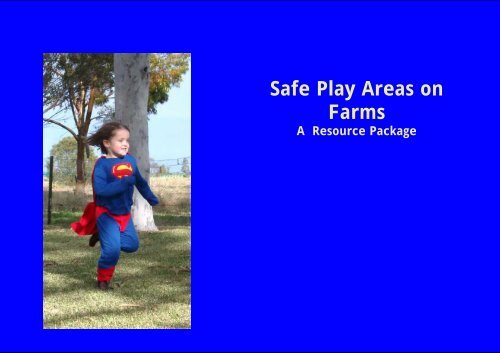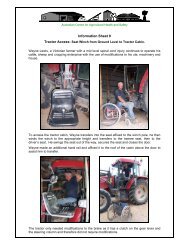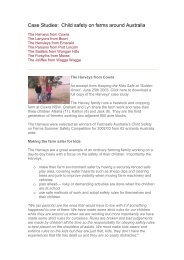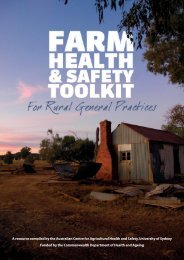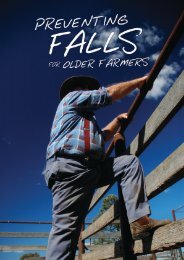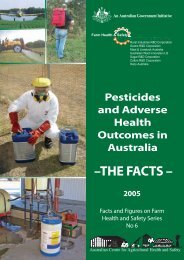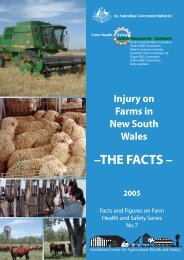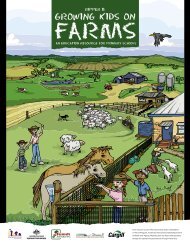Safe Play Areas on Farms - Australian Centre for Agricultural Health ...
Safe Play Areas on Farms - Australian Centre for Agricultural Health ...
Safe Play Areas on Farms - Australian Centre for Agricultural Health ...
- No tags were found...
You also want an ePaper? Increase the reach of your titles
YUMPU automatically turns print PDFs into web optimized ePapers that Google loves.
<str<strong>on</strong>g>Safe</str<strong>on</strong>g> <str<strong>on</strong>g>Play</str<strong>on</strong>g> <str<strong>on</strong>g>Areas</str<strong>on</strong>g> <strong>on</strong><strong>Farms</strong>A Resource PackagePrepared by <strong>Farms</strong>afe Australia as part of its Nati<strong>on</strong>al Child <str<strong>on</strong>g>Safe</str<strong>on</strong>g>ty <strong>on</strong> <strong>Farms</strong> Strategy funded by theComm<strong>on</strong>wealth Department of <strong>Health</strong> and Ageing.The Publicati<strong>on</strong> has been printed by RIRDC who also funded the research <strong>on</strong> fencing opti<strong>on</strong>s <strong>for</strong> rural properties.
C<strong>on</strong>tents1. Purpose of this Resource2. Why are safe play areas a good idea <strong>on</strong> farms?3. Benefits of a <str<strong>on</strong>g>Safe</str<strong>on</strong>g> <str<strong>on</strong>g>Play</str<strong>on</strong>g> Area4. The Role of Supervisi<strong>on</strong>5. Making an Effective Barrier6. A <str<strong>on</strong>g>Safe</str<strong>on</strong>g> <str<strong>on</strong>g>Play</str<strong>on</strong>g> Area in Boort Victoria7. Making a Child Friendly Garden8. <str<strong>on</strong>g>Play</str<strong>on</strong>g> Ideas <strong>for</strong> your <str<strong>on</strong>g>Safe</str<strong>on</strong>g> <str<strong>on</strong>g>Play</str<strong>on</strong>g> AreaAttachment 1: <str<strong>on</strong>g>Safe</str<strong>on</strong>g> <str<strong>on</strong>g>Play</str<strong>on</strong>g> Area Fencing Opti<strong>on</strong>sAttachment 2: Quick ChecklistAttachment 3: Acti<strong>on</strong> PlanAttachment 4: Feedback Sheet9. Useful C<strong>on</strong>tactsThanks and AcknowledgementsThis publicati<strong>on</strong> has been developed thanks to a number offarmers who participated in a child safety <strong>on</strong> farmscompetiti<strong>on</strong> held in 2002/2003.The work of Ros Lany<strong>on</strong>, who w<strong>on</strong> the Victorian Secti<strong>on</strong> ofthe competiti<strong>on</strong> and who is case studied in Secti<strong>on</strong> 6 “A <str<strong>on</strong>g>Safe</str<strong>on</strong>g><str<strong>on</strong>g>Play</str<strong>on</strong>g> Area in Boort Victoria,” <strong>for</strong>ms the basis of secti<strong>on</strong>s 7&8of this document. Other participants are acknowledged inthe text.Also, a number of farmers and other experts participated inthe documentati<strong>on</strong> and assessment of fencing designs as partof a Rural Industries Research and Development Corporati<strong>on</strong>(RIRDC) research project c<strong>on</strong>ducted by the <strong>Australian</strong> <strong>Centre</strong><strong>for</strong> <strong>Agricultural</strong> <strong>Health</strong> in 2004. They are listed in theopening page of Attachment 1.Versi<strong>on</strong> 2 August 2003<strong>Australian</strong> <strong>Centre</strong> <strong>for</strong> <strong>Agricultural</strong> <strong>Health</strong> and <str<strong>on</strong>g>Safe</str<strong>on</strong>g>tyPrepared by <strong>Farms</strong>afe Australia as part of its Nati<strong>on</strong>al Child <str<strong>on</strong>g>Safe</str<strong>on</strong>g>ty <strong>on</strong> <strong>Farms</strong> Strategy funded by theComm<strong>on</strong>wealth Department of <strong>Health</strong> and Ageing.The Publicati<strong>on</strong> has been printed by RIRDC who also funded the research <strong>on</strong> fencing opti<strong>on</strong>s <strong>for</strong> rural properties.
Why are safe play areas a good idea <strong>on</strong> farms?1. Kids are being hurt <strong>on</strong> farmsThere are significant dangers in the farm workplace to whichevery<strong>on</strong>e - but especially children - are vulnerable. Childrenare regularly injured in farm incidents (30 deaths each yearand 600 hospitalised).The highest “at risk” group is toddlers and the main hazardsare drowning and runover by farm vehicles and mobile plant.Children have travelled 600 metres to drown in a farm dam.Nina and Chris Hensley QLD Cattle property:“I am particularly c<strong>on</strong>cerned about water hazards, agriculturalchemicals and pois<strong>on</strong>ous plants. My husband is more aware ofdangers surrounding farm machinery and stock. Together I hope weprovide a safe envir<strong>on</strong>ment <strong>for</strong> our children which doesn’t hindertheir natural curiosity and development.”Nina was successful in having the fence around the house yard fixedwhen she let Chris to look after the kids <strong>on</strong>e day with firminstructi<strong>on</strong>s that they weren’t to go near the shed. “The next dayour yard was made secure.”Both Nina and Chris believe that creating exclusive “out of bounds”area feeds curiosity. They see supervised explorati<strong>on</strong> as a way ofremoving the mystery and the likelihood that their children will sneakaway to explore these areas <strong>on</strong> their own.2. The farm workplace is not a good place to be lookingafter childrenOff-farm childcare is not always available <strong>for</strong> farm familiesand caring <strong>for</strong> a child within the farm workplace is not ideal:! It is especially difficult <strong>for</strong> adults to always takesufficient care when they are busy working and/ortired! Children are regularly injured in the farm workplacewhile in the care of an adult! Many farm activities are not always predictable eg.,horses or cattle can do the unexpected.Children are not generally “looked after” in other workplacesettings with significant dangers eg., a factory or a mine site3. A child’s behaviour is never entirely predictableChildren are:! curious, quick and determined when they decide to dosomething (eg., run to greet Dad, or catch a pet)! not able to always make the right judgements in theinterests of their own safety – <strong>for</strong> example, they can“freeze” when c<strong>on</strong>fused or frightened or run in fr<strong>on</strong>tof a car to pick up a toy! not reliable rule followers - children can’t alwaysremember or apply the rules.4. It’s too late <strong>on</strong>ce it happensThe c<strong>on</strong>sequences - whether it is your child or a visiting child– are devastatingPage 2
Benefits of a <str<strong>on</strong>g>Safe</str<strong>on</strong>g> <str<strong>on</strong>g>Play</str<strong>on</strong>g> AreaWhat are the benefits?A safe play area:! defines the boundary between the “home” and the“workplace” where different standards and rules canapply – it recognises that the workplace c<strong>on</strong>tainsdangers that generally d<strong>on</strong>’t exist in the home andthe distracti<strong>on</strong>s <strong>for</strong> adults are greater (as they goabout their work);! stops a child from easily/quickly crossing thatboundary without the knowledge or approval of anadult; it can also help stop farm hazards from gettingnear the children (eg horses, cattle)! makes supervisi<strong>on</strong> of children at play moremanageable! helps manage child visitors who may not understandfarm hazards so well! is a place where adults and children can relaxtogether – where a short diversi<strong>on</strong> or lapse insupervisi<strong>on</strong> is not critical and where work doesn’t getc<strong>on</strong>fused with play! is practical and relatively low cost! helps professi<strong>on</strong>al farmers/farm managers meet OH&Sduty of care obligati<strong>on</strong>s.A safe play area is NOT:! a way of keeping children <strong>on</strong> a farm wrapped in“cott<strong>on</strong> wool”. Children who grow up <strong>on</strong> farms have aw<strong>on</strong>derful level of freedom and an opportunity tolearn about the envir<strong>on</strong>ment and nature in ways notavailable to children in urban areas. However untilthey are developmentally capable (physically andintellectually) children need to be kept away from thehazards that have the potential to maim and kill (seefact sheet <strong>for</strong> further in<strong>for</strong>mati<strong>on</strong> <strong>on</strong> developmentalcapabilities).! a “pris<strong>on</strong> <strong>for</strong> kids” – it is a place where children’ssocial and developmental needs can be met withoutthe threat posed by hazards in the farm workplace! <strong>on</strong>e hundred percent effective – plan <strong>for</strong> theunexpected; understand the weaknesses andlimitati<strong>on</strong>s of your safe play area! a place where children can remain unsupervised –supervisi<strong>on</strong> appropriate to the age of a child willalways be necessary to ensure the child is safe, happyand occupied in appropriate activities.Page 3
The Role of Supervisi<strong>on</strong>BUT doesn’t it all come down to supervisi<strong>on</strong>?Supervisi<strong>on</strong> is crucial. A safe play area doesn’t replace theneed <strong>for</strong> supervisi<strong>on</strong>, and supervisi<strong>on</strong> does not replace theneed <strong>for</strong> a fenced safe play area. However, how muchsupervisi<strong>on</strong> do children need depends <strong>on</strong> the individual child,the number of children engaged in play and the type andlocati<strong>on</strong> of play. While age can be a general guide, asparents know, all kids are different and need to tailor theirsupervisi<strong>on</strong> accordingly.In the early childhood years children need c<strong>on</strong>stantsupervisi<strong>on</strong> (ie an adult is always within sight and sound ofthe child) during play and “holding hands” or “holding themclose” in the vicinity of hazards. Young children are entirelydependent <strong>on</strong> adults to provide them with appropriate andsafe play opportunities. Adults should provide:! interesting play possibilities! <strong>for</strong> explorati<strong>on</strong> within strict boundaries under carefulwatch! Provide reassurance to children that an adult is near andwill keep them safe! simple explanati<strong>on</strong>s <strong>on</strong> why some things are “off limits”This secti<strong>on</strong> <strong>on</strong> Supervisi<strong>on</strong> is adapted from Nati<strong>on</strong>al Children’s Center <strong>for</strong> Ruraland <strong>Agricultural</strong> <strong>Health</strong> and <str<strong>on</strong>g>Safe</str<strong>on</strong>g>ty (2003) Creating <str<strong>on</strong>g>Safe</str<strong>on</strong>g> <str<strong>on</strong>g>Play</str<strong>on</strong>g> <str<strong>on</strong>g>Areas</str<strong>on</strong>g> <strong>on</strong> <strong>Farms</strong>.Marshfield, WI: Marshfield Clinic. http://research.marshfieldclinic.org.auAs children get older they have increased mobility andrequire larger spaces <strong>for</strong> play. They begin seeking newplay/recreati<strong>on</strong> experiences that are more complex and maypose greater risk. They still do not fully understand hazardsand their potential c<strong>on</strong>sequences. They need c<strong>on</strong>stant orintermittent supervisi<strong>on</strong> (ie where an adult might be out ofsight and sound <strong>for</strong> short periods) during play in a safe playarea. Adults can:! Be firm, c<strong>on</strong>sistent & promote respect <strong>for</strong> safety rules! Take questi<strong>on</strong>s seriously and explain c<strong>on</strong>sequences ofunsafe play! Explain how and where to c<strong>on</strong>tact an adult quickly incase of emergencyAs the children become more capable the period where theymay be able to play independently of an adult will increaseand more reliance can be placed <strong>on</strong> setting and en<strong>for</strong>cingc<strong>on</strong>sistent rules.Rob and Sue Pars<strong>on</strong>s SA Sheep property:“We have lots of dams including <strong>on</strong>e right next to the house. The kidsare amazed that there are crocs here in SA … there’s even a sign upwhich warns them.”As well as this “psychological” measure they also have fenced barriers.“We have two cycl<strong>on</strong>e fences around the dam. The outer <strong>on</strong>e is thefence of the house yard and then there is a lane way between it and thesec<strong>on</strong>d <strong>on</strong>e which is of smaller squares. If they make it through the firstthe sec<strong>on</strong>d <strong>on</strong>e generally puts them off. Other water hazards such astroughs and dips we keep covered.”Page 4
Making an Effective BarrierA safe play area is <strong>on</strong>ly as effective as the barrier <strong>for</strong>med bythe fence and gates (including latches, closing mechanisms).A range of factors need to be c<strong>on</strong>sidered in determining thebest type of fence or fences <strong>for</strong> a given rural setting. Anumber of fence designs comm<strong>on</strong>ly used by farmers/graziershave been identified and assessed in a research projectfunded by the Rural Industries Research and DevelopmentCorporati<strong>on</strong>.Attachment 1 provides a summary outcome of this researchand will assist in selecting a suitable fence design.There are, however some general principles (also identifiedthrough this research) that should be c<strong>on</strong>sidered whendesigning a fence and safe play area and these are describedin this secti<strong>on</strong> of the guide.Attachment 2 provides a quick checklist that can be used toassess the quality and improvement needs of your currenthouse yard/safe play area fence.Page 5
Making an Effective Barrier<str<strong>on</strong>g>Safe</str<strong>on</strong>g> play area design! C<strong>on</strong>sider the size of the area to be fenced inrelati<strong>on</strong> to the needs of the child and the cost:" a higher quality “child resistant” fence<strong>for</strong>ming a small safe play area is betterthan a lower effectiveness fence <strong>for</strong>ming alarger safe play area." a smaller, higher quality fenced areawithin a house yard may be a good opti<strong>on</strong><strong>for</strong> young children and/or visitors and maybe removed when children get older.! Keep vehicles/driveways out of the fencedarea.Fence structure! Ensure the fence is at least 1.2 metres high(pool fence standard). Note that 1.5 metres isnow the standard <strong>for</strong> many child care centres! Ensure a maximum clearance of 100mm from the ground.! Use fencing materials that do not provide children with ahand and foothold to assist climbing (this can includecommercially available fencing materials or can beimprovised – <strong>on</strong>e farmer used c<strong>on</strong>veyor belting obtainedcheaply from a local mine).! Keep diag<strong>on</strong>al stays <strong>on</strong> the outside of the fence orpreferably use box stays so that a child cannot usethem as a foothold.! Ensure the surface under the fence and gates is notsubject to erosi<strong>on</strong>/wear to provide possible access.Page 6
Making an Effective BarrierGates and Latching MechanismsThe most appropriate type of gate and latch mechanism willdepend <strong>on</strong> a range of factors including how many gatesthere are, who uses them (eg visitors, c<strong>on</strong>tractors) and whatis <strong>on</strong> the outside of the gate. In general:Diagram: Gate Latch Formats! Gates are often a critical weakness as they can so easilybe left open - so minimise the number of gates to keepcosts down and reduce risk.! Ensure that the gate is c<strong>on</strong>sistent with the fence inheight and c<strong>on</strong>figurati<strong>on</strong> to maintain child resistantproperties and place latches at least 1.5metres from theground.! A proven automatic latch (such as the “Magnalatch”)with a gate closing mechanism should be used whereverpossible (especially <strong>on</strong> high usage gates).! A screw type manual latch can be useful to stop olderchildren opening gates <strong>for</strong> younger children! C<strong>on</strong>sider using a “please close the gate” sign <strong>on</strong> allentrances to the safe play area and a “please hold myhand” sign <strong>on</strong> the inside to remind people to hold youngchildren close when they are taken into the farmworkplace.! C<strong>on</strong>sider placing a bell <strong>on</strong> comm<strong>on</strong>ly used entrances toprovide an audible signal that the gate is beingopened/closed.Page 7
Making an Effective BarrierOther Factors! C<strong>on</strong>sider the age, size, agility and nature of the children. Prepare <strong>for</strong> the unexpected – d<strong>on</strong>’t assume that because achild hasn’t wandered be<strong>for</strong>e that they w<strong>on</strong>’t tomorrow.! C<strong>on</strong>sider special circumstances with visiting children – younger children may follow older children who may not be asreliable as adults in providing care.! C<strong>on</strong>sider the level and intensity of adult supervisi<strong>on</strong> <strong>for</strong> children within the safe play area.! Ensure that items in the safe play area cannot be used to assist climbing over the fence.! Dangerous areas adjacent to play areas could be signposted to make visitors aware of the presence of children, such as“children - slow down”.Lyn and Graham Harvey, NSW livestock and cropping farm :To create a securely fenced house yard the Harveys have:! Built a side fence al<strong>on</strong>g the drive between the house and thegarage to separate where vehicles enter/exit and the houseyard! Built a net fence <strong>on</strong> the dam side of the house with straightwires <strong>on</strong> the outside so that there were no footholds <strong>for</strong>climbing! Fitted gates leaving the house with fine mesh to make themunclimbable! A cubby house, swings and trampoline were placed so that ahead count of children could be made with a glance from thekitchen or laundryAs well, a row of shea oaks were planted al<strong>on</strong>g the fence line to makethe dam look less inviting, the dog kennel was moved to under a bigtree outside the yard and leaky, unstable water tanks were removed.“To date I’ve never had a child wander from the yard while playing.But its not something you can rely <strong>on</strong> totally … you still have to keepan eye <strong>on</strong> them. It’s when they go quiet that you start to worry. Alsoyou have to drum it into them. The dam and the road are out ofbounds!”Page 8
A <str<strong>on</strong>g>Safe</str<strong>on</strong>g> <str<strong>on</strong>g>Play</str<strong>on</strong>g> Area in Boort VictoriaRoslyn and Isaac Lany<strong>on</strong> and theirchildren Brydie(8), Otis(6) and Tillie-Mae(4) were the winners of theVictorian child safety <strong>on</strong> farms awardpresented at Victoria <strong>Farms</strong>afe Forumby Paul Weller President of theVictorian Farmers’ Federati<strong>on</strong> in 2003.The Lany<strong>on</strong>’s live <strong>on</strong> a 400 hectarecropping and sheep property near thetown of Boort in the north of Victoria.Isaac is a third generati<strong>on</strong> farmer.Their key strategies <strong>for</strong> keeping theirchildren safe <strong>on</strong> the farm are:supervisi<strong>on</strong> - <strong>on</strong>e of the keyreas<strong>on</strong>s <strong>for</strong> Roslyn's decisi<strong>on</strong> tostay at home as a fulltime Mum,farm office worker and farmassistant; anda safe play area has beenc<strong>on</strong>structed to <strong>for</strong>m a barrierbetween the children and farmhazards.<str<strong>on</strong>g>Safe</str<strong>on</strong>g>ty has always been an importantc<strong>on</strong>siderati<strong>on</strong> and incidents at homeand locally have rein<strong>for</strong>ced the need<strong>for</strong> acti<strong>on</strong>.“the farm safety competiti<strong>on</strong>highlighted the need <strong>for</strong> seatbelts inthe ute – which is <strong>on</strong>e of our slackareas. We now insist <strong>on</strong> the use ofseatbelts.And we never let the kids<strong>on</strong> the back of the ute. They alwaysnag, but we never give in!”The farm includes a dangerousirrigati<strong>on</strong> channel close to the house.“We d<strong>on</strong>’t tell the kids that thereare crocodiles in the water, we tellthem that they can drown. We readthem stories out of the paper thatremind them what can happen <strong>on</strong>farms.”Roslyn believes that an interestingoutside envir<strong>on</strong>ment is vital tokeeping children within ‘safe’ areas.Some of the key features of theirw<strong>on</strong>derful safe play area include:a 1.2 metre fence c<strong>on</strong>structedfrom wire mesh with improvisedself latching gatesPart of the Lany<strong>on</strong>’s <str<strong>on</strong>g>Play</str<strong>on</strong>g> Area“I have yet to see a child successfullyclimb it. Most people have houseyards, but many are inadequatelyfenced if they are intended to keepthe kids inside.”The area can be visually patrolledfrom the kitchen and office and isan adequate distance from theworkshop and machinery shed.The play area is large (23m by27m) with age-specific playequipment and activities including:• A trampoline at ground level(built above a pit)Page 9
A <str<strong>on</strong>g>Safe</str<strong>on</strong>g> <str<strong>on</strong>g>Play</str<strong>on</strong>g> Area in Boort Victoria• A cubby <strong>on</strong> several levels, butwith ladders which can beremoved depending <strong>on</strong> the ageof visiting children• A completely shaded sand pitand an expanse of open lawn• In summer a shallow wadingpool is placed under a shadytree and is <strong>on</strong>ly used <strong>for</strong>“buddy” swimming and undersupervisi<strong>on</strong>• A thoughtful selecti<strong>on</strong> of plants(<strong>for</strong> smell and eating), places<strong>for</strong> the children to sit and pathsthat take them throughinteresting spaces• The play area can bepartiti<strong>on</strong>ed from the rest of thehouse yard and temporaryfences and gates have beenused at times to keep littlechildren in the correct areas.As the children get older andtheir play interests change,they play in other areas of theyard.During school holidays Roslyn andthe children and plan specialtheme days, interesting activitiesand family outings.Roslyn’s primary teaching backgroundmeans that she takes into accountchildren’s developmentalcharacteristics when deciding what toallow them to do:“We d<strong>on</strong>’t let our children <strong>on</strong>motorbikes. I’m a bike educati<strong>on</strong>teacher and I know their limitati<strong>on</strong>s …tunnel visi<strong>on</strong> <strong>for</strong> example. Childrenare unpredictable, and like to pushthe boundaries as much as possible.Our farm is not perfect by any meansand there may be many things wehave ‘got wr<strong>on</strong>g,’ but <strong>on</strong>ly furthereducati<strong>on</strong> will help us. We areprobably ‘over safe’ at times,especially with visitors – but you cannever be too careful.”Page 10
Making a Child Friendly GardenSome tips <strong>on</strong> making your play area great place <strong>for</strong> kids:Look at the big picture, but start small. Work out what yourgarden and children need and work from there. Get the kidsin <strong>on</strong> the act - if they’re old enough. Ask them about theirideas. Involve them!Depending <strong>on</strong> the age of the children most gardens need:<str<strong>on</strong>g>Safe</str<strong>on</strong>g>ty! All safety aspects should be looked at - the mostimportant fencing - fence off pools, cover p<strong>on</strong>ds,fence play area and secure gates. The play area isbest to be in clear view of the house.! Make sure the area that they will be using the most insummer has some <strong>for</strong>m of shade - tree, sail, umbrella.Different areas & play equipment! An area <strong>for</strong>: running, jumping, climbing, sliding,hiding, chasing, pretending and sitting. Sometimeschildren need to disappear into their own world andhide.! Forget the pre-fab cubby. How many are actually usedanyway? Bushes, trees, or maybe a blanket tent canbecome the most desired thing in the garden.! A grassed area is needed!!! Maybe a paved area <strong>for</strong> bikes and trikes.Something to eat! Kids like to eat things - so planning to put some fruittrees; vegies or a strawberry patch in the garden or inpots will be greatly appreciated.! Have child friendly plants - choose the right <strong>on</strong>es.Aromatic, hardy, 'doesn't mind a lot of acti<strong>on</strong>" typeplants. Avoid toxic - berries, sap, foliage, spinyleaves, and sharp-edged leaves. See the list followingof things that are best kept in another part of thegarden, or not in the garden at all.Some fun stuff! Something to climb! Fun things to do - grow a geranium in your old boots,grow potatoes in a bucket or sprout some seeds <strong>on</strong>cott<strong>on</strong> wool inside an eggshell.! Plant colour. Plant a range of flowers and colour - butbe prepared to have them picked! A wide shallowc<strong>on</strong>tainer is usually the best vase.! Pers<strong>on</strong>alize the garden - pavers, mosaics, snappysticks, garden stakes, sculptures, different gardenbeds, rocks, teapots or anything else you or your kidsthink of.Page 11
Making a Child Friendly GardenWhat Children Like! Children d<strong>on</strong>'t care what a garden looks likeaesthetically; Children like order in a garden - butalso love the wild parts! Young children d<strong>on</strong>'t always enjoy a large garden -more secure in an enclosed area! For 6 years plus, the bigger the garden the better <strong>for</strong>hide-and-seek, cricket, riding! Children like to go round and round - dead ends aren'tmuch fun, a flower bed, bird bath, shrub or tree <strong>for</strong>them to chase around is a good idea! Children need territories and places - what looks likea normal back yard is actually a place of w<strong>on</strong>der ~adventure and different area-jungle, p<strong>on</strong>d, shadycorners, bush area, behind the garage! Children like privacy - they like the feeling that theycan't be watched from the house -obscuring the viewsas they get older with shrubs, bushes, trees etc.! Children like surprise - gardens with several secti<strong>on</strong>shave an appeal, a secret path, or a hidden comer! Children like <strong>for</strong>bidden places - like the shed roof, thejunk pile, or under things - so check periodically <strong>for</strong>dangers - electrical wires, spiders, snakes, rustyturned up nails, bottles of pois<strong>on</strong>, broken glass etc.! Children have time - and need a spot to sit and d<strong>on</strong>othing - a lawn, verandah, step or back door! Children are destructive - they whip plants, pick flowertops, tramp over garden beds, and use pot plants <strong>for</strong>their games - rules and reminders are important! Children need tough plants in play areas - <strong>on</strong>es thatw<strong>on</strong>t be broken, or destroyed during the normal gamesin the garden! Children like water and mud - channeling, damming,racing sticks etc.! Children rarely work in the garden - they love to plant -but often weeding and watering is a bit of a hassle -helping plant and working in the garden may bepreferable than giving them their own plot straight off! Children like low plants and garden creatures! They enjoy challenging and scary things - climbing atree or m<strong>on</strong>sters in the garden! Children like open space - <strong>for</strong> running! Children like rituals - a pet's grave, feeding the chooks,games - step <strong>on</strong> the crack..etc! Children d<strong>on</strong>'t like change - so if planning any majorchanges -do it in small changes and include them indiscussi<strong>on</strong>s and plansPage 12
<str<strong>on</strong>g>Play</str<strong>on</strong>g> Ideas <strong>for</strong> your safe play area<str<strong>on</strong>g>Play</str<strong>on</strong>g>ing is important <strong>for</strong> children to develop physically,emoti<strong>on</strong>ally, socially and intellectually. An ideal play areablends activities matched to the developmental stages andabilities of children.Provide play structures and materials in your safe play areathat will allow children to experience the following types ofplay:! Balance play! Ball play! Climbing play! Fantasy play! Manipulative play! Riding play! Sliding play! Swinging playPage 13
<str<strong>on</strong>g>Play</str<strong>on</strong>g> Ideas <strong>for</strong> your safe play areaBabies Love:! Parents and other children! Watching things that move, thatare bright, patterned or shinyToddlers! Painting! <str<strong>on</strong>g>Play</str<strong>on</strong>g> dough! Sandpit3-Year Olds (As <strong>for</strong> toddlers plus)! Outdoor play equipment! Small building or box <strong>for</strong>crawling in/decorating4 Year Olds (As <strong>for</strong> 3 yrs plus)! Pretend/imaginative play! Simple games5 Year Olds (As <strong>for</strong> 4 yrs plus)! Skipping rope6 – 8 Year Olds (As <strong>for</strong> 5 yrs plus)! Throwing at targets! Running, skipping, tumbling8-10 Year Olds (As <strong>for</strong> 6-8 yrs plus)! Games of strategy! Outdoor camping! Exploring their world! Being sung to! Attenti<strong>on</strong>! Communicating! Slide! Push-pull toys! Foot propelled bikes! Climbing bars! Tricycles and small pedaltractors! Dressing up! <str<strong>on</strong>g>Play</str<strong>on</strong>g> wheelbarrows, gardeningtools, toy kitchen equipmentetc! Fort, playhouse, tree-house! Bicycles, roller skates, in-lineskates! Team and individual sport! Music, handicraft, woodwork! Reaching and grasping! Being safe, com<strong>for</strong>table andfeeling secure! Listening to sounds! Music! Swings/outdoor play! Big blocks and balls! Swings! Bikes – bicycle course orhopping path! Team ball games! Magic sets! Kite flyingPage 14
<str<strong>on</strong>g>Play</str<strong>on</strong>g> Ideas <strong>for</strong> your safe play area! Beak freaks - spy and identify the different birds in yourgarden! Bird baths, bird houses and bird feeders - attract birds to thegarden! Designate a place in the garden <strong>for</strong> each child as a birthdaygarden. Celebrate each birthday by putting a special plant intheir garden.! Butterfly traps! Corkscrew tendrils are fascinating! Create a water feature - p<strong>on</strong>d, pot, puddle (but rememberthat small children can drown in small quantities of waterand take the necessary precauti<strong>on</strong>s!)! Dance <strong>on</strong> a windy autumn day! Declare a tree in the garden a Wishing Tree - and the kidsrun 3 times around the tree and then make a wish! Designate their own space to dig, plant and be free - sunny,close to water. involve them in plant selecti<strong>on</strong> at the nursery! Dinosaur area, jungle, desert, beach, mountains, under thesea, fairy garden. witches garden, pizza garden, etc! Feely boxes - filled with things from the garden! Fruit shapes - put a mould over a fruit (still <strong>on</strong> the tree) andlet it grow to fit the mould! Go <strong>on</strong> a garden dweller hunt - lizards, beetles an othercreepy crawlies! Have a texture and smell walk! Have kid-sized tools - wheelbarrow, gloves, trowels, pots,watering cans! Listen to tree with a stethoscope - you are suppose to beable to hear the sap rising – early spring <strong>on</strong> deciduous trees! Make a book out of zip lock bags. Collect treasures and writewhat they are.! Make garden ornaments- paver, statues, stakes, windsocks,chimes etc! Musical instruments - clap sticks, shaker using seed pods! Nasturtiums leaves - water resistant leaves - roll a droparound the leaves! Obstacle course! Plant a row of faces (Pansies)! Press or dry flowers! Scarecrow - make a scarecrow - dress him in old clothes -and d<strong>on</strong>’t <strong>for</strong>get a hat! Tea party in the garden.! Treasure hunt - using clues to discover the hidden pleasuresof the garden! Use - bells, wind chimes, wind socks to give a sense oftheatre to the garden! Use the weather reports - check and plot the temperatureand rainfallPage 15
<str<strong>on</strong>g>Play</str<strong>on</strong>g> Ideas <strong>for</strong> your safe play areaThere are many ways to use the yard to create ! Fairies/elves exciting play experiences <strong>for</strong> your ! Nature children. Here are a few “brainstormed” ! Textures ideas to use as astarting point:! Fairy tales! Nursery rhymes! Travel! Animals! Antarctica! Apple bobbing! Art and craft! Autumn! Backwards Day! Balancing! Birds! Black and white! Bridges and tunnels! Bubbles! Camouflage! Computers! C<strong>on</strong>cert! C<strong>on</strong>structi<strong>on</strong>! Cooking! Countries! Deserts! Dinosaurs! Disguises & pretending! Dolls! Drama! Dreams! Experiments! Family picnic day -traditi<strong>on</strong>al games egegg and spo<strong>on</strong>! Farm day! Film and film stars! Flying! Food! French cricket! Funny things! Future! Gold! Halloween! Hobbies andcollecti<strong>on</strong>s! Homemade books! Hopscotch! Horse! Houses! Insects! Inventi<strong>on</strong>s! Jungle! Kites! Light! Listening activities! Lost and found! Machines! Magic! Mazes! Music! Myths and legends! Obstacle course! Olympics! Paper planes! Past! Patterns! Photographs! Picnic, bbq, eatingout! Planets! <str<strong>on</strong>g>Play</str<strong>on</strong>g>s! Princess – prince! Quoits! Railways! Rope fun! Sack races! Sand play! Science! Shadows! Shopping! S<strong>on</strong>g producti<strong>on</strong> –using tape recorder! Space explorati<strong>on</strong>! Sp<strong>on</strong>ge targets! Spring! Statues! Summer! Teddy Bears! Treasure! Trees! Tug of war! Tunnels! Under the sea! Zoo! Video producti<strong>on</strong> – aday in the life of me.! Voyages and journeys! Water play! Weather! Wheelbarrow races! Wheels! Wild west! Wishes! Yo-yo funPage 16
Attachment 1: <str<strong>on</strong>g>Safe</str<strong>on</strong>g> <str<strong>on</strong>g>Play</str<strong>on</strong>g> Area Fencing Opti<strong>on</strong>sIn a research project funded by the Rural Industries Research andDevelopment Corporati<strong>on</strong> (RIRDC), fence designs were collectedfrom farmers, fencing manufacturers and c<strong>on</strong>tractors. An expertpanel (see opposite) assessed the designs against the followingcriteria to provide guidance <strong>on</strong> the pros and c<strong>on</strong>s <strong>on</strong> each design:• Effectiveness of structure as a “child resistant” barrier(the Pool Fencing Standard(AS 1926:1993) was used as aguide).• Potential to injure or harm a child attempting to climb thefence• Robustness/durability/capability to withstand typical<strong>for</strong>ces/corrosi<strong>on</strong> and wear resistance• Materials cost and availability• Ease of installati<strong>on</strong>, maintenance requirements• Aesthetics and potential to customiseThe fence designs <strong>on</strong> the following pages include an approximatematerials <strong>on</strong>ly “cost indicator” and a “child resistance” indicator:Improving “Child Resistance”Expert Fence Review Panel1. Maureen Fegan – Kids and Traffic2. Lyn Fragar – Aust <strong>Centre</strong> <strong>for</strong> Ag <strong>Health</strong> and <str<strong>on</strong>g>Safe</str<strong>on</strong>g>ty3. Trish Malins – NSW Commissi<strong>on</strong> <strong>for</strong> Children & Young People4. Lesley Day – M<strong>on</strong>ash University Accident Research <strong>Centre</strong>5. Richard Franklin – Royal Lifesaving6. Matt C<strong>on</strong>d<strong>on</strong>- OneSteel7. David Phillips – <strong>Farms</strong>afe Victoria8. Ros Lany<strong>on</strong> VIC - Farmer9. Gary Lang WA – Farmer10. Sue Patters<strong>on</strong> QLD - Farmer11. Lesley Young TAS - Farmer12. Ian Forsyth NSW - FarmerC<strong>on</strong>tributing Farmers: C<strong>on</strong>tributing C<strong>on</strong>tractors:Renee Burke (NSW) Design #3Kylie Douglas (QLD) Dallas Rumbel [02]49921847Beverley Norman (NSW) Fence Craft and Farm ServicesNoeline Walsh (NSW) NSWGeoff and Lisa Bought<strong>on</strong> (NSW)Alan Kearney (VIC) Design #6Angela D<strong>on</strong>alds<strong>on</strong> (QLD) T<strong>on</strong>y Lavette (02)43247144Rosalyn Lany<strong>on</strong> (VIC) www.profence.com.auBill and Tracey Rad<strong>for</strong>d (WA)Thelma Hutchis<strong>on</strong> (VIC)Beverley Newcomen – RemoteFamily Services Uniting Care (VIC)Leanne Lancey (VIC)Page 17
Design #1: Netting• The fence is made with rabbit or chicken wire, with a 25-40mm aperture & wire thickness of at least 1.4mm.• Horiz<strong>on</strong>tal (selvedge) wires support the netting. They arelocated <strong>on</strong> the outside of the fence to avoid providing afoothold and the bottom wire is pinned or buried toprevent children from sliding underneath.• A standard 1050mm width roll of netting can becombined with a roll of 300mm wide netting ( at thebottom) to make the fence at least 1.2m high.• It is comm<strong>on</strong> to run a barb or electric wire <strong>on</strong> this type offence <strong>for</strong> paddocks.ChildResistanceIndicatorCostIndicator$4- $15/metre123456Effectivenessas a childresistant barrierPotential toinjure a childattempting toscale the fenceRobustness,corrosi<strong>on</strong> andwear resistanceMaterial costand availability.Ease ofinstallati<strong>on</strong>,maintenancerequirements.Aesthetics andpotential tocustomise.Comments <strong>on</strong> Design against Key Criteria• While this fence does not meet pool standards, it has been suggestedthat the wire is not com<strong>for</strong>table <strong>for</strong> toddler’s fingers and toes if they try toclimb it; the aperture size of under 40mm, is too small <strong>for</strong> toddler’s shoes.This may not deter some older/bigger pre-school aged children.• Apertures greater than 40mm reduce barrier effectiveness by making iteasier to climb.• Barb or electric wire increases effectiveness as a child resistant barrier.• The use of barb or electric wire increases the risk of injury to a childshould they attempt to climb the fence.• All wires should be tied off neatly to avoid sharp ends, which may causeinjury.• Wire thicknesses less than 1.4mm are pr<strong>on</strong>e to breakage during normalwear and tear.• Rabbit wire is readily available at rural fencing suppliers.• Installati<strong>on</strong> is straight <strong>for</strong>ward. Regular m<strong>on</strong>itoring of the fence,particularly where stock and farm dogs etc. have access.• Using 300mm netting at the bottom of the fence can extend life of thefence as this narrower piece can be replaced when necessary• If the wire is buried, it may require replacement after a time due to rust.• A wooden post and top rail is often used to improve the appearance ofthis kind of fence.• This fence has the advantage of being very cheap, made of familiar and readilyavailable materials, and is easy to c<strong>on</strong>struct to various support frames.• In the specified dimensi<strong>on</strong>s it provides a moderate level of child resistance <strong>for</strong> toddlers.• A box type stay is preferred to a diag<strong>on</strong>al stay to prevent children climbing them• The expert panel felt that incorporating barb or electric wire, introduces the risk ofinjury and harm to children, and that alternative fence designs are preferable. If a barbor electric wire is essential <strong>for</strong> livestock purposes take child safety needs into account,and make sure that they are well out of reach of young children and that a child couldnot be trapped by the wires.Page 18
Design #2: Fabricated Wire• Prefabricated fences such as “ringlock” “stocklock” or“hingedjoint” are comm<strong>on</strong>ly used <strong>on</strong> a paddock side of thefarm yard. The bottom wire is pinned to the ground toprevent children from going under.• Only c<strong>on</strong>figurati<strong>on</strong>s with max 15cm vertical picket spacingsare likely to prevent a child climbing through.• The pictured example shows ringlock <strong>for</strong> most of the fence,topped with barbed wire, and an electric wire running750mm above ground, displaced 250mm from the fence <strong>on</strong>the paddock side.ChildResistanceIndicatorCostIndicator$4- $20/metre123456Effectiveness asa child resistantbarrierPotential to injurea childattempting toscale the fenceRobustness,corrosi<strong>on</strong> andwear resistanceMaterial cost andavailability.Ease ofinstallati<strong>on</strong>,maintenancerequirements.Aesthetics andpotential tocustomise.Comments <strong>on</strong> Design against Key Criteria• This fence is not effective as a child resistant barrier, as it is easilyclimbable. Children may also stretch the wire secti<strong>on</strong> (depending <strong>on</strong>size) to go under.• The use of barb or electric wire increases the effectiveness as a childresistant barrier.• The use of barb or electric wire increases the risk of injury to a childshould they attempt to climb the fence.• Depending <strong>on</strong> the aperture size, there is a risk of head entrapment ifthe child attempts to crawl through the fence.• All wires should be tied off neatly to avoid sharp ends which may causeinjury.• This is a robust and l<strong>on</strong>g lasting fence.• Ringlock, Stocklock, or Hingedjoint is readily available at rural fencingsuppliers. If purchasing materials, ensure that you order the 1150 mmwidth roll, and not the more comm<strong>on</strong> 900mm width roll.• Installati<strong>on</strong> is straight <strong>for</strong>ward. Regular m<strong>on</strong>itoring of the fence,particularly where stock and farm dogs etc. have access, is necessaryto ensure its integrity.• A wooden post and top rail is often used to improve the appearance ofthis kind of fence.• This fence is cheap, made of familiar and readily available materials, and is easy toc<strong>on</strong>struct to various support frames.• Prefabricated type fencing provides a poor level of child resistance, compared withother designs as children can readily climb over or under the wires.• The expert panel felt that incorporating barb or electric wire, introduces the risk ofinjury and harm to children, and that alternative fence designs are preferable.• The level of child resistance may be improved by the additi<strong>on</strong> of a layer of netting (seedesign 3).Page 19
Design #3: 12.5mm Mesh• The use of a 1200x12.5x1.3 welded mesh over a new orexisting fence. Aspects of this fence design:(1) The mesh must be protected by a top rail, such timberor steel.(2) A middle and bottom horiz<strong>on</strong>tal (selvedge) wire <strong>on</strong> theoutside supports the mesh.(3) The mesh is effectively “tensi<strong>on</strong>ed” by clipping it to thefencing wires, that are offset by being threaded throughwooden fence posts.$16-30/metre123456Effectivenessas a childresistantbarrierPotential toinjure a childattempting toscale the fenceRobustness,corrosi<strong>on</strong> andwearresistanceMaterial costandavailability.Ease ofinstallati<strong>on</strong>,maintenancerequirements.Aesthetics,and potentialto customise.Comments <strong>on</strong> Design against Key Criteria• This fence makes a very good barrier, and may meet the pool standards.(AS1926:1993 requires physical testing, which is yet to be c<strong>on</strong>ducted <strong>for</strong>this design).• The risk of injury is low.• A pre-galvanised mesh is preferred to a post-galvanised mesh may havesharp excess pieces of zinc.• This is a robust and l<strong>on</strong>g lasting fence. The mesh is the weakest aspect,and m<strong>on</strong>itoring will be required to ensure its integrity.• This mesh, often referred to as “birdwire”, is readily available at ruralfencing suppliers. If purchasing materials, ensure that you order the 1200mm width roll, and not the more comm<strong>on</strong> 900mm width roll. Also ensurea wire thickness of 1.3mm or greater.• Installati<strong>on</strong> is straight <strong>for</strong>ward. Regular m<strong>on</strong>itoring of the fence,particularly where stock and farm dogs etc. have access, is necessary toensure its integrity.• A wooden top rail is often used to improve the appearance of this kind offence. The mesh can be painted dark green or black (easiest d<strong>on</strong>e whilestill in the roll) to reduce its visual impact.• This fence has the advantage of being relatively cheap, looks good, and can be madeusing readily available materials and familiar methods.• The mesh can be fitted to an existing fence with a top rail (at a relatively low cost toimprove the child resistant quality.• This fence provides a relatively high level of child resistance.ChildResistanceIndicatorCostIndicatorThis design was c<strong>on</strong>tributed by fencing c<strong>on</strong>tractor Dallas Rumbel - Fence Craftand Farm Services. C<strong>on</strong>tact details are <strong>on</strong> the first page of this attachmentPage 20
Design #4: Solid Fencing• Corrugated ir<strong>on</strong>, or colorb<strong>on</strong>d steel panels (shown) or othersolid materials (eg., used c<strong>on</strong>veyor belting) provide anattractive child resistant fence. Any necessary supportinghoriz<strong>on</strong>tal structure should be <strong>on</strong> the outside of the fence.• In high winds gates made of solid material may swing openunder sustained pressure$16-30/metre123456Effectivenessas a childresistantbarrierPotential toinjure a childattempting toscale the fenceRobustness,corrosi<strong>on</strong> andwearresistanceMaterial costandavailability.Ease ofinstallati<strong>on</strong>,maintenancerequirements.Aesthetics,and potentialto customise.Comments <strong>on</strong> Design against Key Criteria• This fence makes a very good barrier, and meets the pool standards at aminimum height of 1.2m.• In high wind gates made of solid material may swing open if latches arenot suitably robust• The risk of injury is low if top and bottom rails are used to protect thesharp edges as shown.• This is a robust and l<strong>on</strong>g lasting fence.• Colorb<strong>on</strong>d comes at a higher cost than corrugated ir<strong>on</strong>. Both materialsare readily available.• Installati<strong>on</strong> is straight <strong>for</strong>ward.• Cannot see through the fence - whether this is seen as an advantage ordisadvantage will depend <strong>on</strong> what is <strong>on</strong> the other side.• The fence may be used to block noise, wind and dust• Colorb<strong>on</strong>d comes in a range of colours and styles.• This fence is of moderate cost, and provides a high level of child resistance. Part ofthe fence could be c<strong>on</strong>structed using these materials, particularly to screen noise,dust, wind, and to provide privacy.ChildResistanceIndicatorCostIndicatorPage 21
Design #5: Chain Wire12Effectiveness as a childresistant barrierPotential to injure a childattempting to scale thefenceComments <strong>on</strong> Design against Key Criteria• This fence does not meet the pool standards, and is easily climbable, dueto the large aperture sizes, and the sturdy c<strong>on</strong>structi<strong>on</strong>.• At 1.8m, the fence provides a higher degree of child resistance.• At 1.8m, there is an increased risk of child injury if they fall in an attemptto climb over the fence.3456Robustness, corrosi<strong>on</strong>and wear resistanceMaterial cost andavailability.Ease of installati<strong>on</strong>,maintenancerequirements.Aesthetics, and potentialto customise.• Chain wire is sturdier than chicken wire, and is durable and with a l<strong>on</strong>glife.• Chain wire is of low cost, and is readily available. However, the mostcomm<strong>on</strong> supporting structure is round hollow secti<strong>on</strong> galvanised pipe,which is approximately $20 per metre <strong>for</strong> materials <strong>on</strong>ly.• This cost is naturally higher <strong>for</strong> a 1.8m fence.• Installati<strong>on</strong> is straight <strong>for</strong>ward, with low maintenance requirements.• A wooden post and top rail is often used to improve the appearance ofthis kind of fence.• This fence is easily climbable. There are other opti<strong>on</strong>s available that are equally attractive anddurable, but provide a better barrier <strong>for</strong> children.• The “chain wire” fence is popular, and used invarious c<strong>on</strong>figurati<strong>on</strong>s. It often accompanies around hollow secti<strong>on</strong> steel frame, or a post andrail arrangement, as shown.• This material has been used at heights of 1.2mand 1.8m.ChildResistanceIndicatorCostIndicator$16-30/metrePage 22
Design #6: 5mm Wire Panel! This fence is manufactured in panels 3m wide, by 1.2m high.The wire thickness is 5mm, and is erected by tech screwingthe panels to RHS posts.! The distance between the furthest apart horiz<strong>on</strong>tal supports is800mm, which makes it difficult <strong>for</strong> a young child to scale thisfence.$16-30/metre123456Effectivenessas a childresistantbarrierPotential toinjure a childattempting toscale the fenceRobustness,corrosi<strong>on</strong> andwearresistanceMaterial costandavailability.Ease ofinstallati<strong>on</strong>,maintenancerequirements.Aesthetics andpotential tocustomise.Comments <strong>on</strong> Design against Key Criteria• This design has been developed to target the rural farmyard market,and comes close to, but does not quite meet the pool standard.• There may be a risk of head or limb entrapment in the vertical secti<strong>on</strong>sdue to the flexibility of the 5mm wire.• This product is galvanised, and is there<strong>for</strong>e l<strong>on</strong>g lasting.• The cost is approximately half of similarly designed pool compliantfences.• Installati<strong>on</strong> is straight <strong>for</strong>ward, with low maintenance requirements.• It is possible at additi<strong>on</strong>al cost to paint or powder coat this product toimprove the appearance.! This design offers good potential to provide a relatively high child resistant fence –particularly <strong>for</strong> younger children - at moderate cost, <strong>for</strong> rural settings.• Further field testing is necessary to further assess design integrity, safety anddurability.ChildResistanceIndicatorCostIndicatorThis gate design was c<strong>on</strong>tributed by fencing manufacturer and c<strong>on</strong>tractor T<strong>on</strong>yLavette of Profence. C<strong>on</strong>tact details are <strong>on</strong> the first page of this attachment.Page 23
Design #7: 5mm Wire Mesh! This fence is manufactured in panels 3m wide, by 1.2m high.The wire thickness is 5mm, and is erected by tech screwingthe panels to RHS posts.! This can be seen as an example of any mesh fence, wherethe horiz<strong>on</strong>tal wire supports are close enough together toprovide a sturdy climbing support.123456Effectivenessas a childresistantbarrierPotential toinjure a childattempting toscale the fenceRobustness,corrosi<strong>on</strong> andwearresistanceMaterial costandavailability.Ease ofinstallati<strong>on</strong>,maintenancerequirements.Aesthetics,and potentialto customise.Comments <strong>on</strong> Design against Key Criteria• This fence is not effective as a child resistant barrier, and is easilyclimbable.• The risk of injury is low.• This product is galvanised, and is there<strong>for</strong>e l<strong>on</strong>g lasting.• The cost is less than similarly designed pool compliant fences.• Currently this product is widely distributed.• Installati<strong>on</strong> is straight <strong>for</strong>ward, with low maintenance requirements.• It is possible at additi<strong>on</strong>al cost to paint or powder coat this product toimprove the appearance.• This design is not effective as a child resistant barrier, and is easily climbed.$31 - 45/metreChildResistanceIndicatorCostIndicatorPage 24
Design #8: Pool Compliant Fencing! The most cost effective pool compliant fencing of this type c<strong>on</strong>sistsof vertical members that are either 8mm wire, or round / rectanglehollow secti<strong>on</strong> steel.! The distance between vertical members is usually 80 - 90mm.! The distance between the furthest apart horiz<strong>on</strong>tal supports is aminimum of 900mm, which makes it difficult <strong>for</strong> a child to scale thisfence.123456Effectivenessas a childresistantbarrierPotential toinjure a childattempting toscale the fenceRobustness,corrosi<strong>on</strong> andwearresistanceMaterial costandavailability.Ease ofinstallati<strong>on</strong>,maintenancerequirements.Aesthetics,and potentialto customise.Comments Against Key Criteria• These fence designs are pool fence compliant, and arethere<strong>for</strong>e c<strong>on</strong>sidered to be highly child resistant.• Risk of injury is low.• This product is hot dip galvanised, and is there<strong>for</strong>e l<strong>on</strong>glasting.• Cost is over $60 per metre <strong>for</strong> materials <strong>on</strong>ly.• These are standard pool fencing designs, which are widelyavailable.• Installati<strong>on</strong> is straight <strong>for</strong>ward, with low maintenancerequirements.• This product is typically powder coated, with a range of coloursand decorative upper styles available.• These designs offer a highly child resistant fence.• If this type of fencing is c<strong>on</strong>sidered too expensive <strong>for</strong> a large area, a smallerplay area could be c<strong>on</strong>sidered$46+ metreChildResistanceIndicatorCostIndicatorPage 25
Attachment 2: Quick ChecklistThe Risk:⎯ What are the age and number ofchildren who live <strong>on</strong> or visit thefarm/rural property?⎯ How close is any open water, farmmachinery or vehicle hazards?⎯ What is the quality of supervisi<strong>on</strong>available?" Have any “near miss” incidentsinvolving children and farmhazards occurred?The Fence:" Is the fence at least 1.2 m high allthe way around." Is the fence free of gaps, holes ordamaged areas which a child couldget through?" Is the fence low enough (all theway round) to stop a child fromcrawling underneath?" Is the fence checked regularly andmaintained?" Is the fence made from materialsthat a child can’t climb?" Is the fence structure free offootholds (strainer posts, wires)that a child could stand <strong>on</strong>?Gates and Latches:" Are all gates leading from/to thesafe play area at least 1.2 m high?Are they c<strong>on</strong>structed so that theycannot be climbed by a child?" Has the possibility of a childbypassing the safe play area viathe house (eg through an openfr<strong>on</strong>t door) been addressed?" Do the gates have a self-closingmechanism?" If so - is the mechanism reliable& checked regularly?" If no - what is being d<strong>on</strong>e toensure the gate is kept closed?" Are the gate latches “child proof”?" Is the “child proof” latch reliableand checked regularly?" Do you check that visitors areunable to reach/open latches?The Area:" Is the area free of any fixed ormobile structures or trees that achild could climb to get over thefence or reach a gate latch?" Is the safe play area visible fromkey areas of the house?" Is the area free of other risks tochildren (eg are water hazards suchas open topped tanks, p<strong>on</strong>ds,troughs excluded)?" Are all vehicles excluded from thefenced safe play area ?" Is there adequate shade and arethere interesting things to play<strong>on</strong>/with and to do?" Do family rules cover how the safeplay area is used and maintained?" Are these rules regularly rein<strong>for</strong>cedwith children and adults?" Do the rules cover thecircumstances under which a childcan leave the safe play area?Page 26
Attachment 3: Acti<strong>on</strong> PlanImprovement opti<strong>on</strong>s:Immediate Acti<strong>on</strong>:Other Acti<strong>on</strong>:Fencing improvements1.2.3.4.5.Gate and latch improvements1.2.3.4.5.Improvements inside the playarea1.2.3.4.5.Family rule improvements1.2.3.1.2.3.4.5.6.7.8.1.2.3.4.5.6.7.8.by:by:by:by:by:by:by:by:Page 27
Feedback FormIf you have used this guide we would be very interested in your feedback to help improve it <strong>for</strong> other users. Please complete thequesti<strong>on</strong>s below and return it to us by fax (02-6752 6639) or email: lauries@health.usyd.edu.au1. How helpful was the tool overall inreviewing/improving your safe playarea?# Very Helpful# Helpful# Not very helpful# Useless4. What are the biggest risks you aremanaging through your safe play area?------------------------------------------------------------------------------------------------------------------------------------------------------------------------------------------------------------------------------------------------------------------------------------------8. Number of children under 10 wholive <strong>on</strong> the farm/rural property? Plswrite number in box:#9. Type of farm/rural property (maincommodity):-------------------------------------------10. Postcode: --------------------------2. What did you find most helpful?----------------------------------------------------------------------------------------------------------------------------------------------------------------------------------------------------------------------------------------------------------------------------------------------------------------------------------------3. What did you find least helpful?----------------------------------------------------------------------------------------------------------------------------------------------------------------------------------------------------------------------------------------------------------------------------------------------------------------------------------------------------------------------------------------5. Did you identify the need <strong>for</strong> anychanges?# Yes # No6. If yes, what were the main changesyou have made/will make?------------------------------------------------------------------------------------------------------------------------------------------------------------------------------------------------------------------------------------------------------------------------------------------7. Your gender?# Male # Female11. If you would like to receivein<strong>for</strong>mati<strong>on</strong> <strong>on</strong> child safety producedfrom time to time please include yourname and address below:Name:---------------------------------------Postal Address: ----------------------------------------------------------------------------------------------------------------------------------------------------------------------------------------------------------------------------------------------------------------------------------------------------------------------EMail: --------------------------------------Page 28
Useful C<strong>on</strong>tactsThe following organisati<strong>on</strong>s can provide in<strong>for</strong>mati<strong>on</strong> <strong>on</strong> farm safety including training programs and links to farm safety acti<strong>on</strong>groups that may be operating in your local area:<strong>Farms</strong>afe NSWPh: (02) 6752 8214Fax: (02) 67526639<strong>Farms</strong>afe QueenslandPh: (07) 4774 0522Fax: (07) 4774 289<strong>Farms</strong>afe VictoriaPh: (03) 9207 5509Fax: (03) 9207 5510<strong>Farms</strong>afe SAPh: (08) 8232 5555Fax: (08) 8232 1311<strong>Farms</strong>afe WAPh/Fax: (08) 9359 4118Tasmanian Rural Industry TrainingBoardPh: (03) 6331 2131Fax: (03) 63314344<strong>Farms</strong>afe Australia:Ph: (02) 6752 8218Fax: (02) 67526639www.farmsafe.org.auPage 29


